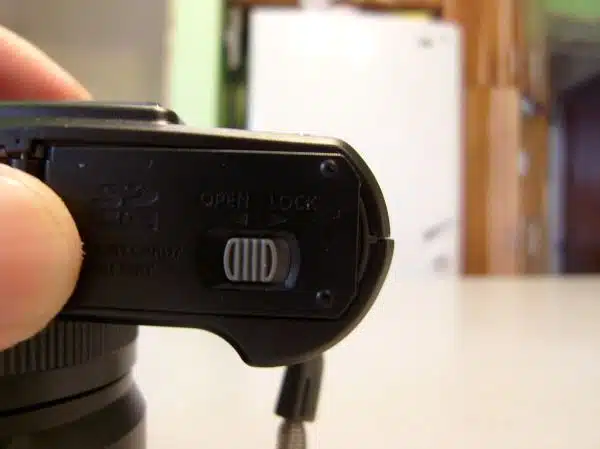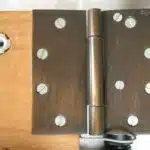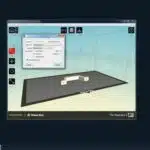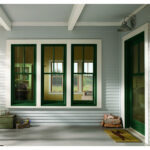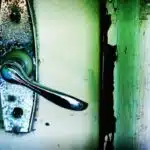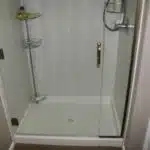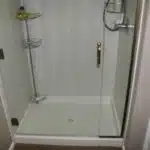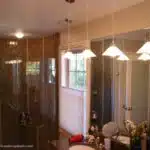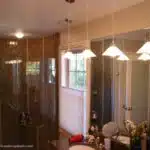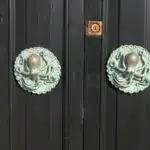Doors are an integral part of any home or building. They not only provide security but also add to the aesthetic appeal of the space. However, a misaligned door can be frustrating and even dangerous if left unaddressed. It can cause damage to the doorframe, result in energy loss due to gaps, and compromise security by leaving the door partially open or closed.
As a professional handyman/carpenter, I have encountered many instances where homeowners have struggled with misaligned doors. While it may seem like a daunting task, fixing a misaligned door is actually quite simple and straightforward with the right tools and techniques. In this article, I will guide you through the steps to identify the problem, diagnose the cause, and provide solutions for how to fix a misaligned door efficiently and effectively.
Signs Of A Misaligned Door
Misaligned doors are a common problem faced by homeowners. They can be caused by various factors such as poor installation, settling of the foundation, or wear and tear over time. Prevention is key to avoiding misalignment, which can have a significant impact on the security of your home.
One of the main causes of a misaligned door is poor installation. If not installed correctly, the door may not fit properly and cause it to become misaligned. Settling of the foundation can also lead to a misaligned door over time. This occurs when the ground beneath the foundation shifts or settles unevenly.
The impact of a misaligned door on the security of your home cannot be overstated. A misaligned door can create gaps between the frame and the door itself, allowing intruders easy access to your home. In addition, it can affect how well your door locks function, leaving you vulnerable to break-ins. It is important to identify any signs of a misaligned door early on to prevent any potential security risks.
Identifying The Problem
Signs of a misaligned door can be frustrating, especially when it fails to close or latch properly. To fix this problem, you need to identify the issue and take appropriate measures. The following section will discuss how to identify the problem with your misaligned door.
One of the most common mistakes people make is overlooking the simple causes of misaligned doors. Before you start any repairs, check if anything is obstructing the door’s movement path, such as debris or furniture. If that does not solve the problem, inspect for gaps between the jamb and the frame on all sides of the door. These gaps indicate where adjustments are necessary.
Prevention tips are essential in ensuring that misaligned doors do not become a recurring issue in your home. One way to prevent this is by periodically checking your door for signs of wear and tear. Regular maintenance checks help identify problems early on, allowing you to address them before they cause significant damage. Another prevention tip is to avoid using excessive force when opening or closing your doors. This can cause undue stress on hinges and screws.
Next, we will discuss how checking hinges and screws can help identify and fix a misaligned door. Inspect each hinge closely for signs of damage or wear, such as loose screws or bent hinges. Tighten any loose screws or replace damaged hardware as needed. Remember that fixing a misaligned door requires patience and attention to detail, so take your time when making these adjustments.
Checking hinges and screws is crucial in identifying solutions for fixing a misaligned door correctly. With proper maintenance and regular checks, you can prevent any further issues from arising in the future.
Checking Hinges And Screws
To fix a misaligned door, one must first check the alignment of the hinges and screws. Misaligned hinges can cause the door to sag or rub against the frame, making it difficult to open and close. Start by examining the hinges to see if they are loose or damaged. If so, tighten any loose screws with a screwdriver or replace any damaged parts.
Once the hinges are secure, lubricating them can help ensure smooth movement of the door. Use a silicone-based lubricant on metal hinges and a dry graphite lubricant on plastic ones. Apply a small amount of lubricant to each hinge and move the door back and forth several times to distribute it evenly.
Checking alignment is crucial in fixing a misaligned door. A misaligned door can cause gaps between the frame and door that allow drafts, noise, and even insects into your home. Check for uneven gaps around all sides of the door by closing it and looking for light coming through any areas where there shouldn’t be any. If you find uneven gaps, it’s time to move onto measuring gaps and alignment to determine how much adjustment is needed.
Next up is measuring gaps and alignment. This step involves using a level tool to confirm whether your door is vertically straight or not. We’ll cover this process in detail in our next section. By following these steps, you’ll be able to determine if more adjustments need to be made beyond checking alignment and lubricating hinges before your misaligned door becomes aligned once again.
Measuring Gaps And Alignment
Back in the day, fixing a misaligned door required a skilled carpenter to take out the entire door and re-install it. However, modern technology has made the process much easier with DIY tools and equipment that anyone can use. To measure gaps and alignment, you’ll need a few measuring techniques such as a tape measure, level, and straightedge.
Firstly, use your tape measure to determine the size of the gap between the door and the frame. This will help you decide how much adjustment is needed. Next, use your level to ensure that the door is not crooked or slanted at any angle. Finally, use your straightedge to check if there are any gaps or unevenness along the edges of the door.
In addition to these measuring techniques, there are also several DIY tools and equipment that can make fixing a misaligned door much simpler. For example, a power drill can be used to loosen screws that hold hinges in place while an electric planer can help shave off small amounts of wood from the edges of a door for better fitting. These tools can be found at most hardware stores or rented out from tool rental shops.
By utilizing proper measuring techniques and DIY tools/equipment, you can fix a misaligned door without having to call in an expensive professional. In our subsequent section about inspecting the door frame, we’ll show you how to identify any underlying issues that may be causing your misaligned door problem.
Inspecting The Door Frame
After examining the door itself, the next step in fixing a misaligned door is to inspect the door frame. This requires measuring tools such as a level, a straightedge, and a tape measure. The purpose of this inspection is to diagnose any issues that may be causing the misalignment.
One common issue with door frames is settling or shifting of the foundation of the home. This can cause the frame to become uneven and result in a misaligned door. Another issue may be due to loose or damaged hinges which can cause the door to sag or lean to one side. Additionally, warping or swelling of the frame due to moisture or temperature changes can also cause a misalignment.
To properly inspect the door frame, begin by measuring each side of the opening from top to bottom with a level and straightedge. If these measurements are uneven, it is likely that there is an issue with settling or shifting of the foundation. Check for any cracks in the walls near the frame which could indicate foundation issues. If all sides are level but there is still a misalignment, check for loose or damaged hinges and warping or swelling of the frame.
By carefully examining the door frame with measuring tools and checking for common issues such as settling, hinge problems, and warping, it is possible to diagnose what is causing a misaligned door. Once determined, proper steps can then be taken to fix these underlying issues and ensure that your door functions properly once again without any further problems arising.
Diagnosing The Cause
After inspecting the door frame, it is time to diagnose the cause of a misaligned door. There are several reasons why a door might not fit correctly into its frame. One of the most common causes is a shift in the house’s foundation or settling due to soil movement, which can cause structural changes that affect the alignment of doors and windows. Another possible reason for misaligned doors is improper installation or wear and tear over time.
To prevent misaligned doors, it is crucial to ensure proper installation from the beginning. This means using quality materials and hiring experienced professionals who understand how to install doors correctly. Additionally, regular maintenance such as lubricating hinges and checking for any warping or damage can help minimize the likelihood of a misaligned door.
If you have determined that shimming the hinges is necessary to fix your misaligned door, there are some important steps to follow. First, remove the hinge pin from one side of the hinge and place a thin shim between the hinge plate and the frame. Then, reinsert the hinge pin and test whether this has corrected the alignment issue. If not, continue adding shims until you have achieved proper alignment. It is essential to use only enough shims as necessary because too many can cause strain on both the hinges and frame, potentially leading to further issues down the line.
Shimming The Hinges
Shimming the Hinges can be an effective way to realign a misaligned door. By using small and thin pieces of material, such as cardboard or plastic, you can place them between the hinges and the doorjamb to adjust the angle of the door. This technique can fix common mistakes like doors that rub against the jamb or don’t latch properly.
When shimming hinges, it’s important to remember that precision is key. Placing shims in incorrect positions can cause more harm than good, causing further misalignment. It’s essential to use only enough shim material needed to make adjustments without overcompensating for the problem. Realigning techniques should be done with care and attention, and it’s always best to measure twice before making any cuts.
One common mistake when shimming hinges is using materials that are too thick or not compressible enough. This can lead to pressure points and prevent proper adjustment. When selecting shim material, choose something that can bend easily and won’t create bulges or extra space between the hinge and jamb. By following these guidelines, shimming hinges can be a simple solution for fixing a misaligned door.
Transitioning into our next section about tightening loose screws, it’s important to keep in mind that this step should only be taken after realigning techniques have been attempted. If there are still issues with your door after shimming hinges, it may be due to loose screws causing instability in the frame. In our next section, we’ll discuss how tightening these screws can provide added support and ensure your door functions smoothly.
Tightening Loose Screws
Identifying Loose Screws: When addressing misaligned doors, it is important to take note of any loose screws that may be present.
Tightening Loose Screws: To tighten loose screws, use a screwdriver to turn the screw in the clockwise direction until it is snug.
Securing Screws: Once the screws are tightened, it is essential to ensure that they are securely in place by firmly tightening them to their original position.
Identifying Loose Screws: To identify loose screws, inspect the door frame and check for any screws that appear to be loose.
Tightening Loose Screws: When tightening the screws, make sure to tighten them evenly to ensure the door remains properly aligned.
Securing Screws: Secure the screws with a screwdriver to ensure that the door remains properly aligned and that the screws remain in place.
Identifying Loose Screws
Identifying Loose Screws is an essential step in fixing a misaligned door. Common mistakes in this process include overlooking small screws or not checking all the screws thoroughly. It’s important to check all screws, even those that seem tight, because they may be masking the problem.
Preventive maintenance is key when it comes to identifying loose screws. Regularly inspecting doors and their hardware can help catch small issues before they become bigger problems. It’s also important to use the correct tools for tightening screws to prevent stripping or damaging them.
When identifying loose screws, start by examining the hinge plates on both the door and frame. If these are loose, it could cause misalignment and affect the operation of the door. Check all screws on both sides of the hinges, as well as any other hardware attached to the door or frame. By taking these steps and practicing preventive maintenance, you can easily identify and fix loose screws for a properly aligned door.
Tightening Loose Screws
Tightening loose screws is an essential step in maintaining the proper alignment of doors. It’s crucial to identify and fix any loose screws as soon as possible to prevent further damage and ensure the door functions properly. Tightening screws may seem like a straightforward task, but it requires care and attention to detail to avoid stripping or damaging the screws.
Before tightening any loose screws, it’s important to inspect all hinges and hardware for any signs of wear or damage. Lubricating hinges can also help maintain their function and prevent further wear and tear. Once you’ve identified all loose screws, use the correct tools, such as a screwdriver or drill, to tighten them securely. Avoid over-tightening the screws, which can cause damage or strip the threads.
After tightening all loose screws, test the door’s operation to ensure it opens and closes smoothly without any issues. Regularly checking for loose screws and performing preventive maintenance can help prolong your door’s lifespan and reduce the need for costly repairs in the future. By taking these steps and using proper techniques, you can ensure that your doors are functional and safe for everyday use.
Securing Screws
When it comes to maintaining doors, tightening loose screws is a crucial step that must not be ignored. However, there are instances when a screw may no longer hold due to wear and tear or damage. In such cases, replacing hardware may be necessary. This is especially true for doors that are frequently used in high-traffic areas.
Before replacing hardware, it’s essential to inspect the door thoroughly to determine the type of hardware required. Also, adjusting tension on certain hinges may help prolong their lifespan and prevent further damage. If tension adjustment fails to resolve the issue, then it might be time to replace the worn-out or damaged hardware.
Securing screws is an essential aspect of maintaining doors’ proper alignment and functionality. Properly tightened screws ensure that the door operates smoothly without any issues. While regular maintenance can help prevent loose screws from happening in the first place, sometimes replacing hardware becomes necessary for optimal door performance. By being proactive with repairs and replacements, you can ensure your doors remain functional and safe for everyday use.
Sanding The Door Edges
Once you have identified that the door is misaligned, sanding the edges can be a simple and effective solution. However, before starting this task, it is important to prepare the door properly to avoid any damage. Begin by removing the door from its hinges and placing it on sawhorses or another stable surface.
Next, inspect the door for any large cracks or warped areas. If there are any major issues, sanding may not be sufficient to fix the problem. In these cases, alternative solutions such as replacing the door or adjusting the hinges may need to be considered.
Assuming that sanding is appropriate for your situation, begin by marking where you will need to sand. This can be done by closing the door and identifying where it is rubbing against the frame. Sand only a small amount at a time and check frequently until the desired fit is achieved. With proper preparation tips and care during sanding, this task can be completed quickly and easily.
Adjusting The Strike Plate
As the saying goes, “a door without a latch is just a wall.” However, even with a properly functioning latch, a misaligned door can be frustrating and potentially dangerous. If your door isn’t closing correctly, adjusting the strike plate may be the solution you need.
Before adjusting the strike plate, it’s important to diagnose any common mistakes that could be causing the misalignment. Check for loose screws on both the hinges and the strike plate itself. Often, tightening these screws can solve the problem without any further adjustments needed. Additionally, make sure that the door itself isn’t warped or damaged in any way.
Once you’ve ruled out these issues, it’s time to adjust the strike plate itself. First, try loosening the screws holding it in place and shifting it slightly up or down as needed. You may also need to file down certain areas of the plate to ensure that it aligns perfectly with the latch when closed. With these strike plate adjustment tips in mind, you’ll be able to fix your misaligned door in no time. If this method doesn’t work for you though, replacing the hinges may be necessary to ensure proper alignment.
Replacing The Hinges
When a misaligned door is causing problems, one solution could be replacing the hinges. Hinges are an important component of any door and, over time, they may wear out or become damaged. Replacing the hinges can help improve the alignment of the door and prevent further damage.
Before replacing the hinges, it’s important to check for any hinge maintenance needs. This includes checking for loose screws and lubricating the moving parts of the hinge. In some cases, this may resolve the misalignment issue without needing to replace the hinges altogether.
If hinge maintenance doesn’t solve the problem, upgrading to higher quality door hardware may be a better option. By investing in better quality hinges and related hardware, you can ensure that your doors will remain aligned for longer periods of time. Additionally, high-quality hardware often comes with improved warranties and customer support which can provide added peace of mind.
Markdown list:
- Check for any loose screws on existing hinges
- Lubricate moving parts of hinge
- Consider upgrading to higher quality door hardware
In order to fully repair a misaligned door, it may also be necessary to address any issues with the door frame. By following proper maintenance steps and investing in high-quality hardware when necessary, you can achieve long-lasting results and avoid future headaches related to misalignment issues.
Repairing The Door Frame
After replacing the hinges, check if the door is still misaligned. If it is, there may be another issue with the hardware or frame. One common problem is worn-out or loose screws that attach the door to the frame. In this case, you can replace the screws with longer and thicker ones or add more screws to reinforce the connection.
Another hardware solution is to install a surface-mounted hinge on the opposite side of the original hinges. This will shift the weight distribution of the door and correct its position. Surface-mounted hinges are available in different styles and finishes, so choose one that matches your existing hardware for a seamless look.
If neither hardware replacement nor reinforcement works, inspect the door frame for any damage or warping. A damaged frame can cause a misaligned door even if all other components are intact. To repair a damaged frame, remove any loose or broken pieces and fill in gaps with wood filler. Once dried, sand down until smooth and paint over to match your existing finish.
Transition: Fixing warped doors requires a different approach than fixing misaligned doors caused by faulty hardware or frames. Let’s explore some solutions in our next section.
Fixing Warped Doors
Imagine a door that no longer fits its frame. It’s like a puzzle piece that doesn’t quite match up, and it can be frustrating to deal with. Warping is one of the most common reasons for misalignment in doors, and it can make opening and closing them a hassle. Fortunately, there are several solutions for removing warping and preventing misalignment.
Firstly, you can try adjusting the hinges on your door. If they are loose or not correctly aligned, this could be causing the misalignment. Tighten any screws that are loose and adjust the hinges as necessary until the door sits flush with the frame.
Another solution is to plane down the edges of your door that are warped. This involves sanding down the areas where the door is rubbing against its frame until it fits correctly again. Be careful not to remove too much material, as this could cause other issues.
Lastly, if all else fails, consider replacing your door entirely. Sometimes warping or damage is too severe to repair effectively, and replacing your door may be more cost-effective in the long run.
By taking action to remove warping or replace your damaged door altogether, you can prevent future misalignments from occurring. Maintaining your doors regularly by oiling hinges and ensuring proper alignment will help extend their lifespan and keep them functioning at their best for years to come.
Maintaining Your Doors
After fixing a warped door, it is important to ensure that proper maintenance is performed to prevent misalignment. Door maintenance involves regular cleaning and lubrication of hinges, knobs, and locks. This helps reduce friction and wear on the door components, which can cause misalignment over time.
Common causes of misaligned doors include loose screws or hinges, swollen wood due to moisture, or an uneven frame. To fix a misaligned door, start by checking for any loose screws or hinges that need tightening. If the issue persists, check if the frame is level using a spirit level tool. If it’s not level, adjust it accordingly until the door fits properly.
Preventing misalignment in your doors requires consistent care and attention. Regularly inspect your doors for signs of damage or wear and address any issues promptly before they become major problems. By taking these steps, you can avoid costly repairs and keep your doors functioning properly for years to come.
Transition: However, even with proper maintenance measures in place, troubleshooting common issues with doors may still be necessary from time to time. Let’s take a look at some tips for identifying and resolving these problems efficiently and effectively.
Troubleshooting Common Issues
As a handyman or carpenter, it is inevitable to encounter misaligned doors. When this happens, it can be frustrating and time-consuming to fix. A misaligned door can cause several issues, such as difficulty in opening or closing the door, gaps between the door and frame, and even security concerns. It is essential to fix a misaligned door promptly to avoid further damage.
Common mistakes when trying to fix a misaligned door are forcing the door into place or tightening screws too much. Forcing the door can cause more damage to the hinges, while over-tightening screws can strip them off completely. These mistakes can lead to expensive repairs that could have been prevented by taking preventative measures.
Preventative measures include regular maintenance of the hinges and checking for any loose screws or bolts. Additionally, if you notice that your door is starting to stick or rub against the frame, address it immediately before it becomes more severe. By taking these preventative measures, you can save yourself time and money down the line.
Fixing a misaligned door may seem daunting at first glance. However, with patience and attention to detail, it can be done efficiently and effectively. Remember to avoid common mistakes by taking preventative measures and seek professional help if needed. With these tips in mind, you’ll be able to tackle any misaligned-door issue with ease!
Conclusion
A misaligned door can be a frustrating issue to deal with, but with the right tools and knowledge, it can be fixed. Signs of a misaligned door include difficulty opening or closing, gaps between the door and frame, and unevenness in the door itself. Identifying the problem requires checking hinges and screws, measuring gaps and alignment, and inspecting the door frame. Once you have identified the issue, repairing or replacing components such as hinges or frames may be necessary.
To fix a warped door, try using a heat gun to apply heat to the affected area while gently bending it back into shape. Maintaining your doors regularly by keeping them clean and properly lubricated will help prevent future issues. Troubleshooting common issues such as squeaking hinges or loose screws can also be easily remedied with basic maintenance.
In conclusion, fixing a misaligned door requires patience and attention to detail. By following these steps for identifying and repairing common issues such as warped doors or loose hinges, you can ensure that your doors are functioning properly for years to come. Remember that regular maintenance is key to preventing future problems from occurring. And always remember: measure twice, cut once!
Image Credits
- “LX3 battery door misalignment” by Thirteen Of Clubs (featured)

